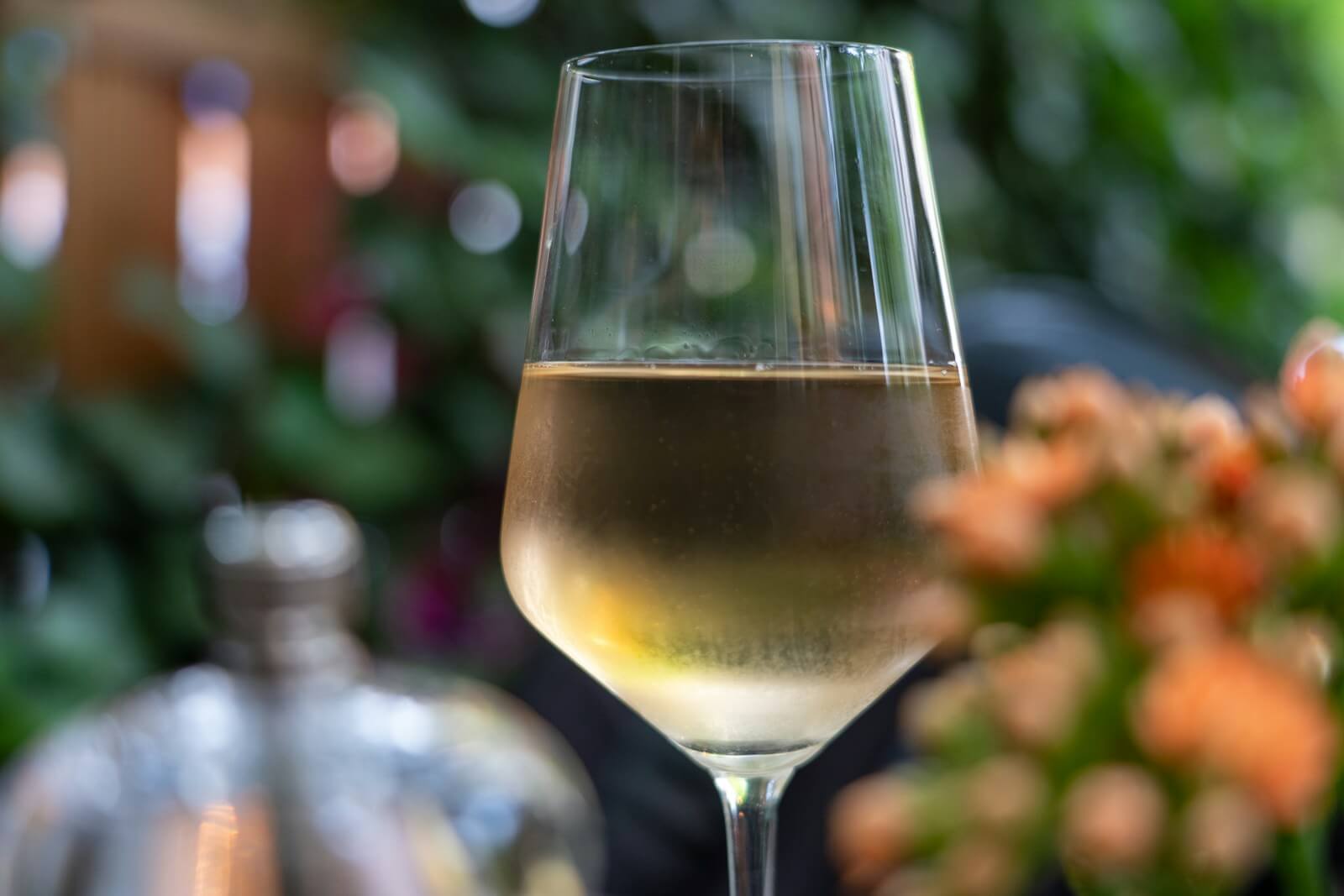
Someone adding white wine to a seafood risotto (Photo by Mironov Vladimir on Shutterstock)
White wine, with its crisp acidity and vibrant fruit notes, transcends its role as a delicious beverage and steps into the kitchen as a culinary chameleon. From deglazing pans to adding a delicate touch to sauces and marinades, white wine unlocks a spectrum of flavors. Its versatility and subtle complexity elevate cooking, and our list of the seven most popular white wines for cooking could be a secret weapon for food enthusiasts everywhere.
Generally speaking, white wine is a bit more versatile in cooking than red wine. White wine is light and crisp, and this helps it to be a solid team player in a supporting flavor role. By embracing the versatility and subtle complexity of white wine in the kitchen, home cooks can unlock a world of culinary possibilities. Our sources helped us learn how to uncork culinary creativity with white wine. We looked through 10 expert reviews to find a consensus on the best white wines for cooking. Let us know your favorites in the comments below!
The List: Best White Wines for Cooking, According to Foodies
1. Sauvignon Blanc
Unleash your inner chef with Sauvignon Blanc, a wine that goes beyond the dinner glass, according to many experts. This vibrant white wine boasts a refreshing flavor profile bursting with citrus and grassy notes, making it the perfect companion in the kitchen.

Here’s why Sauvignon Blanc deserves a spot on your grocery list:
- Cut Through Richness: Wine Folly describes Sauvignon Blanc’s lively acidity as a magic bullet for rich dishes. A splash of this wine can help deglaze pans, creating flavorful sauces that complement heavier meals without being overpowering.
- Marry with Veggies: Looking to elevate your veggie side dishes? Wine Folly suggests Sauvignon Blanc as your secret weapon. Its herbal and floral notes beautifully enhance the taste of vegetables, adding an unexpected complexity to your favorite recipes.
- Versatility is Key: Martha Stewart keeps it simple — any crisp, dry white wine like Sauvignon Blanc will do wonders for your cooking. A quick swirl in the pan adds a touch of sophistication without masking the natural flavors of your dish. So next time you’re at the grocery store, grab a bottle of Sauvignon Blanc – your taste buds (and dinner guests) will thank you!
2. Pinot Grigio
Pinot Grigio’s crisp, fruity notes and light body make it a fantastic choice for adding brightness and acidity to your dishes.

Here’s how Pinot Grigio can elevate your next meal:
-
Bright Acidity: Wide Open Country describes Pinot Grigio as having a “crisp snap” with flavors of melon and apple. This burst of brightness and acidity makes it perfect for deglazing pans, creating flavorful sauces that complement your dish without being overpowering.
-
All-Purpose Versatility: Spoon University likes Pinot Grigio’s chameleon-like qualities in the kitchen. This wine’s neutral flavor profile makes it a perfect match for a wide range of dishes, from creamy pasta to pesto chicken. A splash of Pinot Grigio adds an unexpected layer of complexity without overwhelming the other ingredients.
-
Neutral Mastermind: The Kitchn breaks down the science behind Pinot Grigio’s versatility. They explain that compared to other white wines like Sauvignon Blanc or Chardonnay, Pinot Grigio has the most neutral flavor profile. This neutrality makes it incredibly adaptable, allowing the wine to enhance the flavors of your dish without stealing the show.
3. Dry Marsala
Breathe new life into your savory dishes with Dry Marsala, a nutty wine with hints of caramel that adds a touch of grown-up sophistication. This isn’t your average bottle of plonk – a splash of Dry Marsala transforms ordinary meals into culinary masterpieces.

Here’s why:
-
Rich and Complex Sauces: Unlike bland cooking wines, Dry Marsala boasts a rich, complex flavor profile. The Kitchn suggests using it to create decadent sauces that elevate everything from braised meats to creamy pastas. A little bit goes a long way, adding depth and character without overpowering the natural flavors of your dish.
-
Beyond Chicken Marsala: Sure, The Pioneer Woman says Dry Marsala shines in the classic Chicken Marsala dish, but don’t be afraid to experiment! Branch out and explore its versatility. Its unique flavor profile complements an array of savory dishes, just waiting to be discovered.
-
A Dessert Darling Too: Usual reminds us that Dry Marsala isn’t just for savory dishes. It also plays a starring role in the decadent Italian dessert zabaglione. So next time you’re looking to impress dinner guests, consider a delicious zabaglione for dessert, featuring the unexpected magic of Dry Marsala.
4. Dry Sherry
Unleash your inner culinary ninja with Dry Sherry, a secret weapon that adds unexpected depth to your dishes. This versatile wine goes way beyond the dessert cart, transforming everything from soups to pan sauces with its unique flavor profile.

Check out how to incorporate Dry Sherry below:
-
Flavor Booster Extraordinaire: The Pioneer Woman recommends Dry Sherry for quick pan sauces, cream sauces, and seafood dishes. A splash brightens things up and adds a layer of complexity that’s sure to impress your taste buds. Just remember to skip the sweet cream sherries – they’ll overpower your dish!
-
Soup Savior: The Kitchn shares a secret weapon: add a dash of Dry Sherry to your next pot of soup, like chicken and cauliflower. This simple trick lightens up the flavors and adds an unexpected dimension that will have you wondering where this deliciousness came from.
-
Deglazing Master: Tasting Table breaks down the magic of Dry Sherry. Unlike its sweet counterparts, Dry Sherry boasts a dry profile that makes it perfect for deglazing pans. This technique not only creates flavorful sauces that scrape up all the yummy bits from cooking, but it also adds depth to your dish. Plus, Dry Sherry complements appetizers like oysters beautifully, making it a true kitchen chameleon!
5. Dry Madeira
Dry Madeira is a unique fortified wine that adds a complex, layered flavor to your cooking. Its bold, dry character intensifies sauces and marinades, creating a rich and savory depth for your dishes.

Here’s how Dry Madeira can transform your meals:
-
Rich and Savory Depth: Wide Open Country describes Dry Madeira as having “dry nutty flavors” that perfectly complement savory dishes. A splash intensifies sauces and marinades, infusing them with a richness that elevates everything from chicken to mushrooms.
-
Deglazing Champion: Tasting Table suggests using Dry Madeira to deglaze your pan after cooking meat. This technique not only creates flavorful sauces by scraping up all the crispy bits, but Dry Madeira also adds a depth of flavor that will have you wondering what your secret ingredient is.
-
Beyond the Expected: The Kitchn raves about the versatility of Dry Madeira. They point out that Sercial, a dry style of Madeira, can even be enjoyed as a refreshing aperitif! Plus, Dry Madeira can sub in for Sherry in almost any recipe, making it a great addition to your kitchen arsenal. So next time you’re looking to add a touch of unexpected sophistication to your cooking, reach for the Dry Madeira – your taste buds will take you on a flavor journey to Portugal!
Sources:
- Brewsy
- Wine Folly
- Martha Stewart
- Cook’s Illustrated
- The Pioneer Woman
- The Kitchn
- Usual
- Tasting Table
- Wide Open Country
- Spoon University
Note: This article was not paid for nor sponsored. StudyFinds is not connected to nor partnered with any of the brands mentioned and receives no compensation for its recommendations. This article may contain affiliate links in which we receive a commission if you make a purchase.










